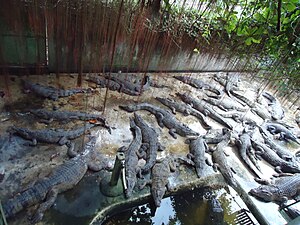
The saltwater crocodile is a crocodilian native to saltwater habitats, brackish wetlands and freshwater rivers from India's east coast across Southeast Asia and the Sundaic region to northern Australia and Micronesia. It has been listed as Least Concern on the IUCN Red List since 1996. It was hunted for its skin throughout its range up to the 1970s, and is threatened by illegal killing and habitat loss. It is regarded as dangerous to humans.
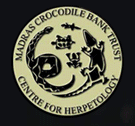
The Madras Crocodile Bank Trust and Centre for Herpetology (MCBT) is a reptile zoo and herpetology research station, located 40 kilometres (25 mi) south of the city of Chennai, in state of Tamil Nadu, India. The centre is both a registered trust and a recognized zoo under the Wildlife (Protection) Act, 1972 and comes under the purview of the Central Zoo Authority, Ministry of Environment and Forests, Government of India. It was established with the aim of saving three Indian endangered species of crocodile—the marsh or mugger crocodile, the saltwater crocodile, and the gharial, which at the time of founding of the trust were all nearing extinction.

The American crocodile is a species of crocodilian found in the Neotropics. It is the most widespread of the four extant species of crocodiles from the Americas, with populations present from South Florida and the coasts of Mexico to as far south as Peru and Venezuela.

The Siamese crocodile is a medium-sized freshwater crocodile native to Indonesia, Brunei, East Malaysia, Laos, Cambodia, Myanmar, Thailand and Vietnam. The species is critically endangered and already extirpated from many regions. Its other common names include Siamese freshwater crocodile, Singapore small-grain, and soft-belly.

The Philippine crocodile, also known as the Mindoro crocodile, the Philippine freshwater crocodile, the bukarot in Ilocano, and more generally as a buwaya in most Filipino lowland cultures, is one of two species of crocodiles found in the Philippines; the other is the larger saltwater crocodile (Crocodylus porosus). The Philippine crocodile, the species endemic only to the country, went from data deficient to critically endangered in 2008 from exploitation and unsustainable fishing methods, such as dynamite fishing. Conservation methods are being taken by the Dutch/Filipino Mabuwaya foundation, the Crocodile Conservation Society and the Zoological Institute of HerpaWorld in Mindoro island. It is strictly prohibited to kill a crocodile in the country, and it is punishable by law.

The New Guinea crocodile is a small species of crocodile found on the island of New Guinea north of the mountain ridge that runs along the centre of the island. The population found south of the mountain ridge, formerly considered a genetically distinct population, is now considered a distinct species, Hall's New Guinea crocodile. In the past it included the Philippine crocodile, C. n. mindorensis, as a subspecies, but today they are regarded as separate species. The habitat of the New Guinea crocodile is mostly freshwater swamps and lakes. It is most active at night when it feeds on fish and a range of other small animals. A female crocodile lays a clutch of eggs in a nest composed of vegetation and she lies up nearby to guard the nest. There is some degree of parental care for newly hatched juveniles. This crocodile was over-hunted for its valuable skin in the mid 20th century, but conservation measures have since been put in place, it is reared in ranches and the International Union for Conservation of Nature (IUCN) lists it as being of "Least Concern".

The Philippine warty pig is one of four known species in the pig genus (Sus) endemic to the Philippines. The other three endemic species are the Visayan warty pig, Mindoro warty pig and the Palawan bearded pig, also being rare members of the family Suidae. Philippine warty pigs have two pairs of warts, with a tuft of hair extending outwards from the warts closest to the jaw. It has multiple native common names, but it is most widely known as baboy damo in Tagalog.

Agriculture in the Philippines is an important sector in the economy with crops like bananas, coconuts, pineapples, rice and sugarcanes are being mass-produced for exportation but the challenge remains as it steadily running into deficit amid growing population. As of 2022, the sector employs 24% of the Filipino workforce and it accounted for 8.9% of the total GDP.

A crocodile farm or alligator farm is an establishment for breeding and raising of crocodilians in order to produce crocodile and alligator meat, leather from crocodile and alligator skin, and other goods. Many species of both alligators and crocodiles are farmed internationally. In Louisiana alone, alligator farming is a $60 to $70 million industry.

The wildlife of the Philippines includes a significant number of endemic plant and animal species. The country's surrounding waters reportedly have the highest level of marine biodiversity in the world. The Philippines is considered one of the seventeen megadiverse countries as well as global biodiversity hotspot. In the 2000 Red List of the International Union for the Conservation of Nature and Natural Resources (IUCN), 418 of the country's 52,177 species were listed as threatened.
Gerardo Valeriano Ortega DVM, better known simply as "Doc Gerry" or "Ka Gerry," was a Filipino journalist, veterinarian, politician, environmental activist, and community organizer best known for his work to promote crocodile farming in the Philippines and for his advocacy against mining on the island of Palawan. Ortega has often been lauded as a hero of the Philippine Environment since his assassination on January 24, 2011, allegedly due to his anti-mining and anti-corruption advocacy.
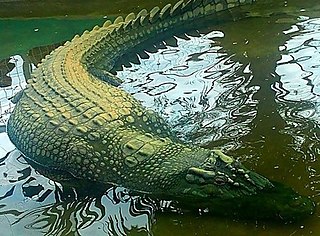
Lolong was the largest crocodile in captivity. He was a saltwater crocodile measured at 6.17 m, and weighed 1,075 kg (2,370 lb), making him one of the largest crocodiles ever measured from snout-to-tail.
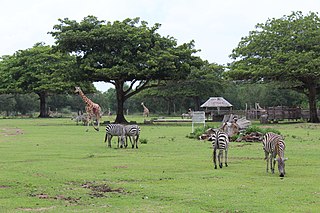
Calauit Safari Park is a wildlife sanctuary in the Philippines which was originally created in 1976 as a game reserve featuring large African mammals, translocated there under the orders of the President Ferdinand Marcos during his 21-year rule of the country.
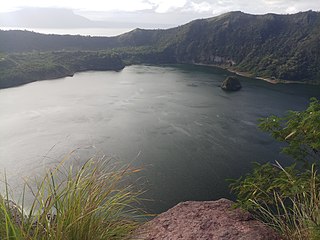
The Luzon rain forests is a tropical moist broadleaf forest ecoregion on the island of Luzon. Luzon is the largest island in the Philippines, and the Luzon rain forests is the most extensive rainforest ecoregion of the country. The ecoregion includes the lowlands of Luzon and neighboring islands below 1000 meters elevation. Very little of the original rainforest remains, and the status of this area is critical/endangered.
The business of ostrich farming in the Philippines began in the Philippines in 1996. It was started by Lorenzo U. Limketkai, an engineer, and his son Heintje Limketkai. Heintje Limketkai took a month-long training course on ostrich farming in Australia. After that training, the Limketkais established their ostrich farming business and named it as the Philippine Ostrich and Crocodile Farms, Inc., becoming the first combined ostrich and crocodile farm in the country.
Cassius is a male saltwater crocodile who was previously recognised by the Guinness World Records as the world's largest crocodile in captivity in 2011. The animal measures 5.48 m in length, weighs approximately 1,000–1,300 kg (2,200–2,900 lb) and is estimated to be more than 110 years old. Kept at the Marineland Crocodile Park, a zoo on Green Island, Queensland, Australia, Cassius was officially recognized by Guinness in 2011, but lost the title in 2012 to Lolong, a 6.17 m saltwater crocodile caught in the southern Philippines. Cassius again holds the record since Lolong's death in 2013.

Fernando Ulson Batul is a Filipino journalist and politician, working as a radio broadcaster for the DYPR in Puerto Princesa, Palawan, was known for his commentaries that were critical of politicians, military officials, rival radio commentators and others. Most of his remarks were made towards the mayor's administration about the quality of governance in Palawan. He had many supporters, but he angered many with his commentaries. He was eventually assassinated and shot six times by men on motorcycles while he was driving, just weeks after grenades were found in his home.

Crocodile skin either refers to the skin of a live crocodile or a leather made from dead crocodile hide. It has multiple applications across the fashion industry such as use for bags, shoes, and upholstery after being farmed and treated in specialist farms and tanneries.

The Luzon montane rain forests is a tropical moist broadleaf forest ecoregion on the island of Luzon in the Philippines. The ecoregion is located on several volcanic and non-volcanic mountains of the island. Luzon is the largest and northernmost major island of the Philippines, located in the western Pacific Ocean.

The Palawan Wildlife Rescue and Conservation Center (PWRCC) is a wildlife rehabilitation and conservation facility and crocodile farm in Puerto Princesa, Palawan, Philippines.
